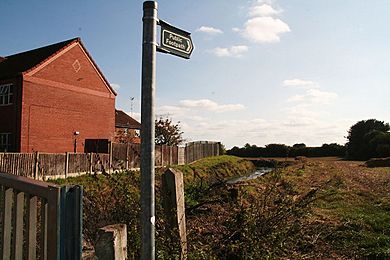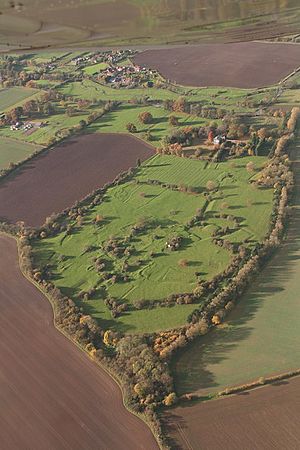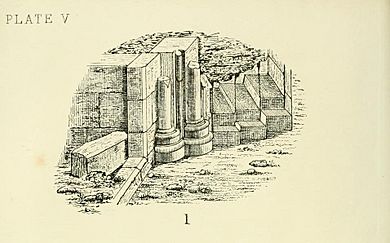Louth Park Abbey facts for kids
Louth Park Abbey was a Cistercian abbey, which is a type of monastery, located in Lincolnshire, England. It was started in 1139 by Alexander of Lincoln, who was the Bishop of Lincoln. This abbey was like a "daughter house" to Fountains Abbey in Yorkshire, meaning it was founded by monks from there.
Contents
Starting the Abbey
Bishop Alexander first offered the monks a place called Haverholme. But the monks didn't think the land was good for farming. So, that land was given to another religious group.
Instead, Bishop Alexander gave the Cistercian monks land in his own park near Louth. The original document, called a charter, said that the Bishop wanted to create an abbey for monks from Fountains Abbey. He granted them his park, "wholly and free from all earthly service." This meant the land was completely theirs to use for the abbey.
The first group of monks who came to the abbey were led by a person named Abbot Gervase.
Abbey Buildings and Land
The abbey was built on a raised area of land, about 23 acres in size. It was located south of the River Lud. The monks used the river to power their grain mill, which Bishop Alexander had given them.
However, the river was too far away for their daily water needs or to fill their fishponds. So, the monks dug a long ditch. This ditch brought water from springs in Louth to the abbey grounds. The ditch split into channels around the abbey, almost like a moat. Water also flowed into two fishponds. One of these ponds was very large and still had fish in it even in the late 1800s!
Today, this main ditch is known as 'Monks' Dyke'. Even though it has changed a lot, it still exists.
The first buildings at the abbey were simple and plain. This was how the Cistercian monks liked their buildings. They were built in a style called Transitional Norman. Pieces of decorative stone from the abbey, now part of a garden folly in Louth, were made between 1140 and 1160. An arch, now in a nearby church, is also thought to be from the abbey and dates to a similar time.
More buildings, like the Chapter-house and Calefactory, were built around 1246. This happened when Abbot Richard of Dunholm was in charge. He helped to rebuild the abbey "from dust and ashes."
By 1291, the abbey was home to 66 monks and 91 lay brothers. Lay brothers were people who joined the monastery but did not become priests. During the Black Death in the 1340s, many monks died. This included the Abbot, Dom Walter de Louth.
A plan from 1873 shows that the abbey had many buildings. These included a church, sacristy, chapter house, storerooms, kitchens, and places for monks and lay brothers to eat and sleep. There was also a guest house and a separate building for sick monks. Outside, there were two fishponds and a burial ground.
The church at the abbey was very long, about 256 feet. This made it 70 feet longer than the nearby St. James Church in Louth. Its walls were 7 feet thick and made from local stone.
The Le Vavasour Family
In the early 1340s, the abbey was having financial problems. So, King Edward III took over its management for a while. Around this time, the Abbot, Walter de Louth, visited Sir Henry le Vavasour, who was very ill. Sir Henry decided to give his manor (a large estate) at Cockerington to the abbey.
Sir Henry wanted to move to the abbey for his health. The Abbot agreed and sent a cart to bring him. Deeds were made to confirm the gift. These documents made sure the abbey's interests were protected, and Sir Henry's wishes were met. His wife, Constance, would receive money each year. After her death, their son would also receive money. Sir Henry also asked the abbey to take in ten more monks. These monks would pray for his soul forever.
Sir Henry's health got worse. The day before he died, he appointed people to make sure his gift to the abbey happened. His wife, Constance, was there but didn't know the details of the gift. She thought it would benefit her.
When the gift was revealed, the monks had already taken control of the manor. Constance then claimed that her husband was not in his right mind when he made the gift. She even said he might have been dead when he signed the document. An investigation was held. Sir Henry's servant, Alice, said that Constance was present and even handed her husband the seal to sign the document. The investigation found the gift was valid, and the abbey kept the manor.
Later, the Black Death reached the abbey. Many monks, including Abbot Walter of Louth, died. He was buried next to Sir Henry le Vavasour in front of the abbey church's main altar.
Gifts and Demands
The abbey received many gifts over time. Important people like Ralph, Earl of Chester, gave money and land. Others gave lands in places like Tetney and Elkington. These gifts were confirmed by King Henry III in 1224 and King Edward III in 1336.
Towards the end of the 1100s, one gift showed the monks were skilled ironworkers. Sir Water de Abbetoft gave them woods near Brampton, Derbyshire. This gift included rights to ironstone and wood for fuel. It also gave them a bloomery, which is a furnace for smelting iron, and a forge for working metal.
King John stayed at the abbey for a night on January 18, 1201. He was touring Lincolnshire at the time. During his reign, he was said to have demanded a lot of money from the abbey. He took about 1,680 marks, which was a very large sum back then.
The Abbey's End
The abbey's wealth and number of monks decreased over time. When it was closed down by King Henry VIII on September 8, 1536, there were only ten monks and Abbot George Walker left. The Abbot received a pension, and the monks shared some money. They also got extra money to buy regular clothes.
One monk, William Moreland, later remembered that they first lived close to their old monastery. They would go to church in Louth or talk with each other. Moreland was having breakfast with another former monk when they heard the alarm. This alarm signaled the start of the Lincolnshire Rising, a rebellion against the King. Moreland joined the protestors and was later executed as a traitor.

The abbey site was first given to Thomas Burgh. But two years later, Henry VIII gave it to Charles Brandon, 1st Duke of Suffolk. This was a thank you for Suffolk's help in stopping the Lincolnshire Rising. This rebellion had started at St. James Church in Louth. Later, around 1570, Elizabeth I gave the park to Sir Henry Stanley and his wife.
In 1643, during the English Civil War, fighting happened in and around Louth. Sir Charles Bolles gathered soldiers for the King's side. After the fighting, three soldiers were killed and buried in Louth. Human remains found at the abbey in the late 1800s were thought to be from the Civil War. Two cannonballs from that time were found with the bodies.
Ruins and Discoveries
An old drawing from 1726 shows parts of the abbey's stone walls still standing. Another drawing from 1770 shows a similar view of the ruins.
In 1818, Thomas Espin designed the new town hall in Louth. He was allowed to use materials from the old town hall to build his own house, called The Priory. He also took "sculptural fragments" from the abbey ruins. He used these, along with other old stonework, to create a decorative structure called a folly by his garden lake. One piece is a Romanesque head with curly hair and a beard. Other pieces are capitals, which are the top parts of columns, often decorated with leaves.
In 1850, an arch was found in a nearby field. It was then moved and used in St. Margaret's Church in Keddington. This arch has special decorations and dates back to the 1100s. It is believed to have originally been part of the abbey.
In 1873, the owner of the abbey site, Mr. W. Allison, dug up the ruins. He found the stone coffins of two former abbots buried in the chapter house. He also found many other interesting old items. The Louth Museum now has one of these abbots' coffins, which dates from the 1300s.
The third All Hallows' Church at Wold Newton was built in 1140. It lasted until 1643. In the 1880s, unusual column bases and tops were found in the walls of the local manor house. They were very large and had a unique design. People thought they might have come from the abbey. They were last known to be in the manor house garden. A heavy stone block in St. Andrew's church in Stewton is thought to be a keystone from the abbey's vaulted ceilings.
Today, what remains of the abbey are mostly earthworks, which are changes in the shape of the land. Of the church, only parts of the north and south walls of the chancel (the area around the altar) and the base of a nave pillar are left. These ruins are considered a very important historical site, known as a Grade I listed building.
Images for kids





